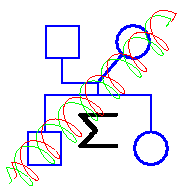
1. In a population of pea plants, the frequency of the red-flower color
allele (R) is 0.7 and the frequency of the white flower-color allele (r)
is 0.3.
The red allele (R) is dominant to the white allele (r).
A pea plant with red flowers and known genotype Rr, is mated
to a pea plant with red flowers and unknown genotype.
(a) In the population,
what is the probability that a pea plant has red flowers?
(b) For the mating,
what is the probability that the red-flowered parent plant of
unknown genotype has genotype RR?
(c) What is the probability that this plant will pass on an R allele; an r
allele?
(d) What is the probability that the two specified red-flowered
plants will have an offspring that is
RR; Rr; rr?
2. For the ABO blood types, the frequency of the A allele is 0.3, of the B
allele is 0.1, and of the O allele is 0.6.
A person of blood type AB, and a person of blood type A but with an
unknown genotype, have a child.
(a) In the population, what is the probability that a person will be AA, AO?
(b)
For the specified parents.
what is the probability that their child is
AA, AB, BB, AO, BO, OO?
(c) The child is found to have blood type A. What is the
probability that this child is AA, AO?
(d) If the child is AO, what is the probability that the parent of blood type
A is AA, AO?
3. For the Cystic Fibrobis (Cf) locus,
the population frequency of the normal allele is 0.975 and
of the recessive mutant allele is 0.025.
Two people, who are phenotypically normal but have unknown genotypes,
have a child.
(a) In the population, what
proportion of phenotypically normal people are carriers?
(b) For these phenotypically normal parents,
what is the probability that their child has Cf?
(c) Given that their child is phenotypically normal (i.e. does not have Cf),
what is the probability that this child is a carrier?
4. The following comes from a real study, here at UW, and concerns typing of
a family at a genetic marker locus with codominant alleles here labelled
A, B, C and D.
An (untyped) couple have six kids.
Three kids are typed and are all type BD.
The other three are untyped, but have children.
(i) Untyped kid1, has spouse
type AD, and 4 typed children, AB, BD, AB, and CD.
Question: if no errors, what type was kid1?
(ii) Untyped kid2, has spouse type AC, and two typed children, types AA
and AC.
Question: if no errors, what can be said about the type of kid2?
(iii) Untyped kid3 and his untyped spouse have four typed children,
types AC, BC, AD, and BC.
Question: what does this tell us about the types of kid3 and his spouse?
(a) Is there a problem with these data? Why?
(b) Is it more likely a pedigree error or a typing error?
What additional information might help resolve that?
(c) Where is the error, most likely? Identify some possibilities.What additional information might help resolve that?
5. (Mather's formula, Mather (1938))
Comment: It is always true that each chiasma in a
meiosis involves two of the four chromatids, and hence has probability
1/2 of being in a resulting gamete.
Mather assumed only no chromatid interference.
That is,
each chiasma has probability
1/2 of being in a resulting gamete, INDEPENDENTLY of the others.
(a) Show by induction (or elsehow if you prefer), that if a fair coin
is tossed any number of N of times (N>0), the probability of an odd
number of heads is 1/2.
(b) By letting N be the number of chiasmata on the tetrad between
two loci of interest,
deduce Mather's formula, that the recombination probability is
(1/2) P(N>0), where N is the random
number of chiasmata between the two loci in a meiosis.
| UW - Statistics: Wednesday, 24-Jul-19 | Contact: Elizabeth Thompson <eathomp@u.washington.edu> |